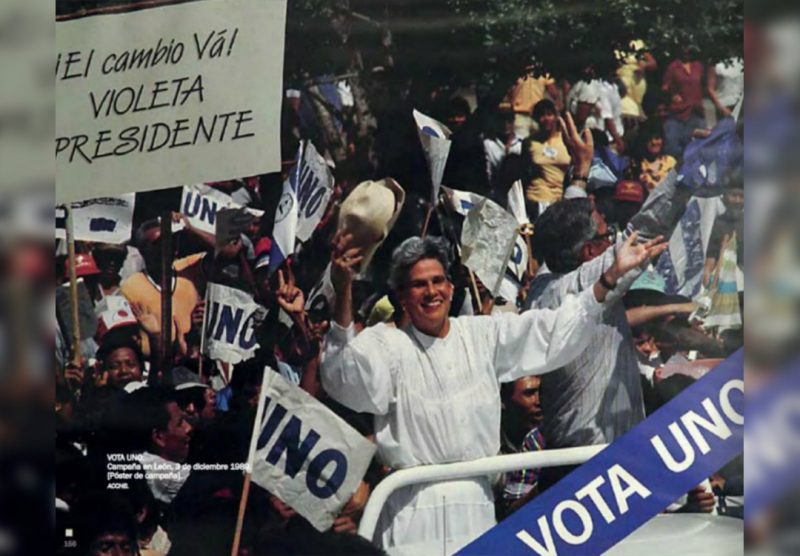History Holds the Lessons for Nicaragua’s Future

What must we do to avoid the repetition of these tragic cycles of dictatorship, war and pacts made in inner circles?
By Enrique Saenz (Confidencial)
HAVANA TIMES – February 25th should be a day of commemoration for Nicaraguans. But it isn’t. Beyond the rejections or adhesions that it provokes among a few, the reality is that the majority of our population is indifferent to the date, and that’s regrettable. Our ignorance of our history, or our feeling of being fed up by the accumulated disappointments, are surely at the root of this indifference.
But it’s not too late to try and recover the meaning of this day, and to encourage a deep reflection that could bring us to a better understanding of our present and our future.
Up until 1990, Nicaraguan history was characterized by recurrent cycles of dictatorship, war, and pacts made in inner circles. The peace that resulted from these pacts was always precarious, because it only served as a preamble to the cycle’s rebirth. And that’s how it’s been for nearly two centuries. As a people, it would seem that we carry a mark from birth. When we were born as an independent country, we opened our eyes to anarchy and violent confrontation, and we were never able to shake off that birth trauma.
The defeat of the Somoza dictatorship (1979) and the course of history it led to neatly illustrates the persistence of these cycles.
Let’s review a little:
The pact forged by two caudillos, Fernando Aguero and Anastasio Somoza, and sealed in 1971, ended the Conservative Party’s opposition to Somoza and smoothed the way for the consolidation of the dynastic dictatorship. The Somoza regime then closed off all the political spaces until it was confronted by the opposition of an entire society. The dictatorship’s insistent clinging to power led to the legitimization of armed struggle as the only path to liberty. And the war came. Every war is a tragedy.
The Somoza dictatorship was overturned, and the Sandinista revolution came to power with the hope that we could build a new Nicaragua. However, a hegemonic and authoritarian vision of a vanguard was imposed, a vision that, once again, divided our society into two hostile bands. Then there was the aggravating factor that the fratricidal war was inserted within a broader theater of global confrontation between the great powers of that time, the United States and the Soviet Union. Band against band, like bellicose pawns of the cold war. A new war and a new tragedy.
Finally, after a rocky road of negotiation, and an enormous cost in blood, death, exile, pain and destruction, we arrived at February 25, 1990. The Nicaraguan people faced the challenge with valor and voted for peace and democracy.
I have to recognize that I was on the other side: although I never did so again, in 1990 I voted for the Sandinista Front. Still, that doesn’t hold me back, on the contrary, I feel even more obligated to carry out this reflection on our history.
Later came April 25 [date the UNO coalition assumed power], another arduous process of negotiation which resulted in Violeta Chamorro taking over the government, even though the Sandinista Front held on to important spaces and quotas of power. Later, on June 27, the process of disarmament and demobilization of the Nicaraguan Resistance (the Contras) was culminated. More than 22,000 combatants turned in their arms.
The complex process of democratic transition that was inaugurated thirty years ago today left as its most outstanding legacy three posterior electoral periods and three peaceful presidential successions for the first time in our history. But neither the democracy nor the peace was immediate. The pacification process was seeded with uprisings: armed groups of the former Sandinistas, the former contra, and some mixed together. But still the peace went forward, hand in hand with democracy, even though the fragile democracy suffered ambushes and harassment from their allies and adversaries.
The republic had barely begun to babble and take its first steps when it was cut down in one blow. The phantasms were reincarnated. A pact was sealed between Arnoldo Aleman and Daniel Ortega, another pact between two caudillos whose central purpose was to impose a two-party system, closing political spaces, and dividing up power between both of the bosses while negotiating impunity for the corrupt.
In addition, the percentage of the vote needed to win the presidential election on the first round was reduced. This division left the pact’s slower party picking their noses off to one side of the road, while the other took off with all the bets, the payola, the table and even with the dice. That’s how the way was paved for Ortega’s return to power.
The rest is our contemporary history: well-documented electoral frauds; the shredding of our republic’s precarious institutions; and the squashing of three historic conquests that the people had paid for with blood – free elections with respect for the popular vote; the principle of no indefinite presidential succession; and the national character of the armed forces. Ortega finished them all off.
The April 2018 explosion was preceded by acts that announced the squall. Rural people killed. A squashing of all opposition demonstrations. Electoral violence that left beaten, prisoners and deaths. Without traveling far back, in the 2017 municipal elections. And so, thirty years later, we’ve arrived at a new tragedy.
What lessons does this thirty-year history leave us with? What does it fall on us to do as Nicaraguans to avoid the repetition of these tragic cycles? What should we change in ourselves and as a society to assure ourselves that our yearning to build a country with freedom, peace and justice isn’t once again shattered?
The last word is yours.





